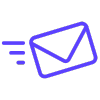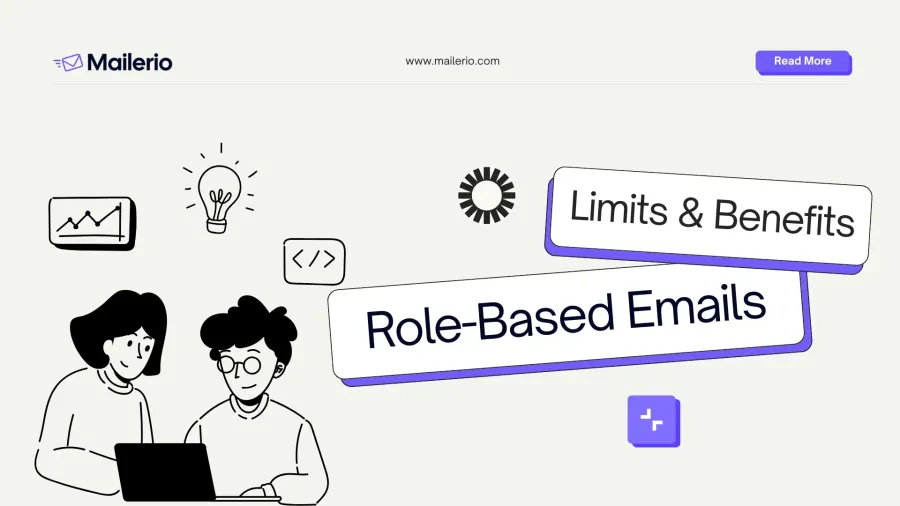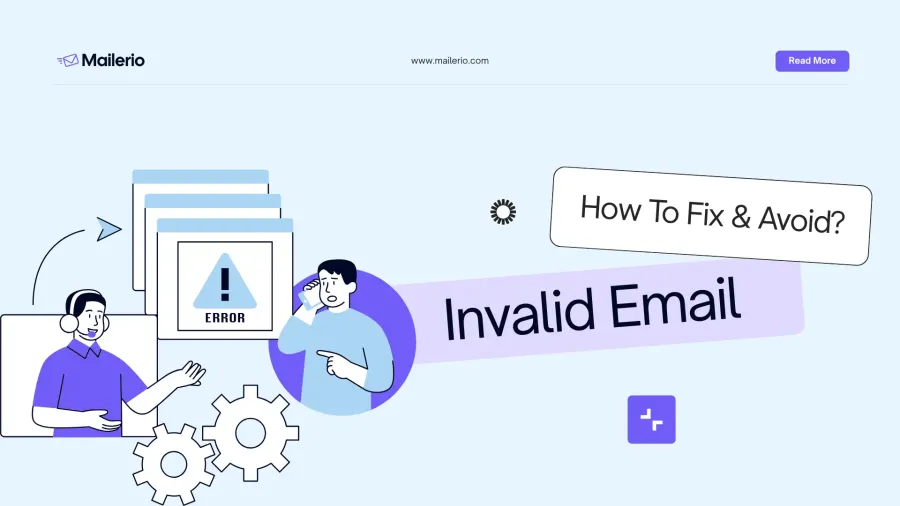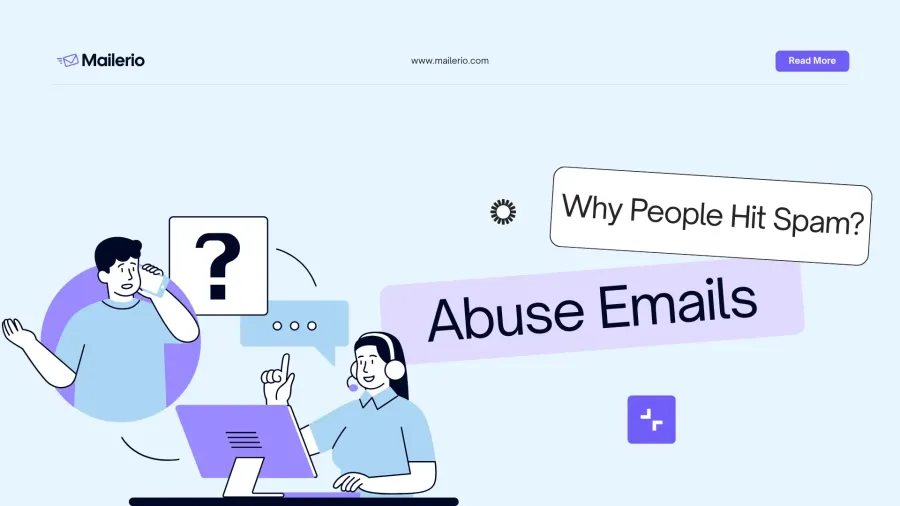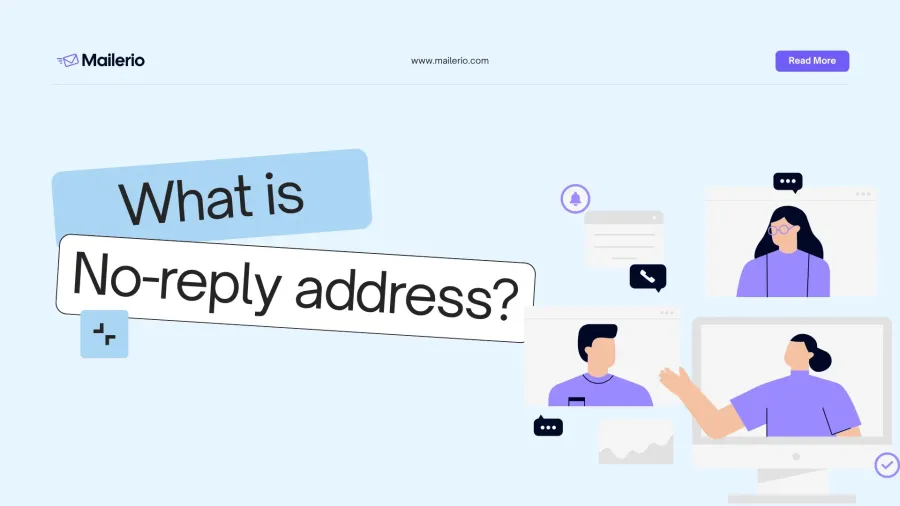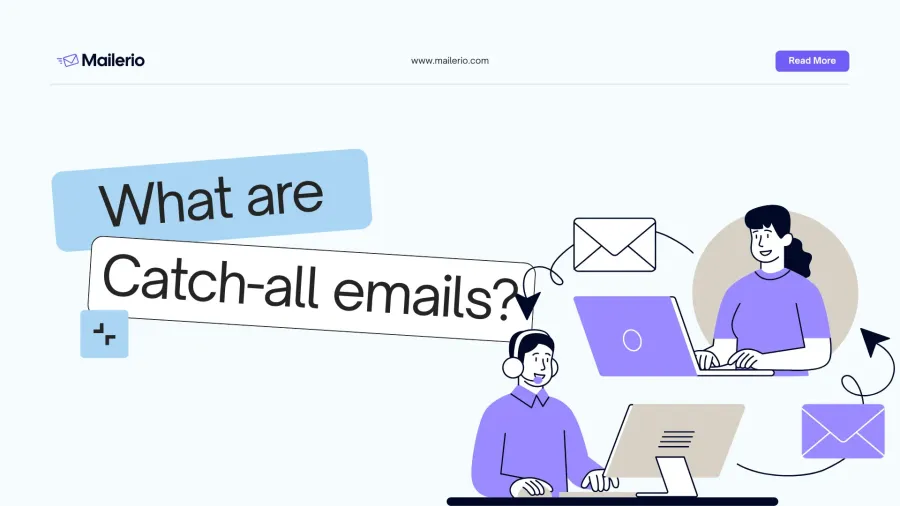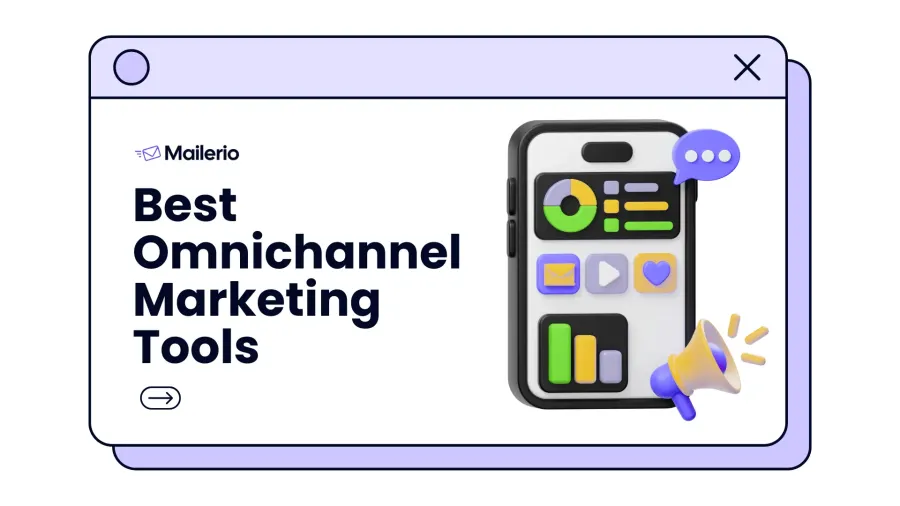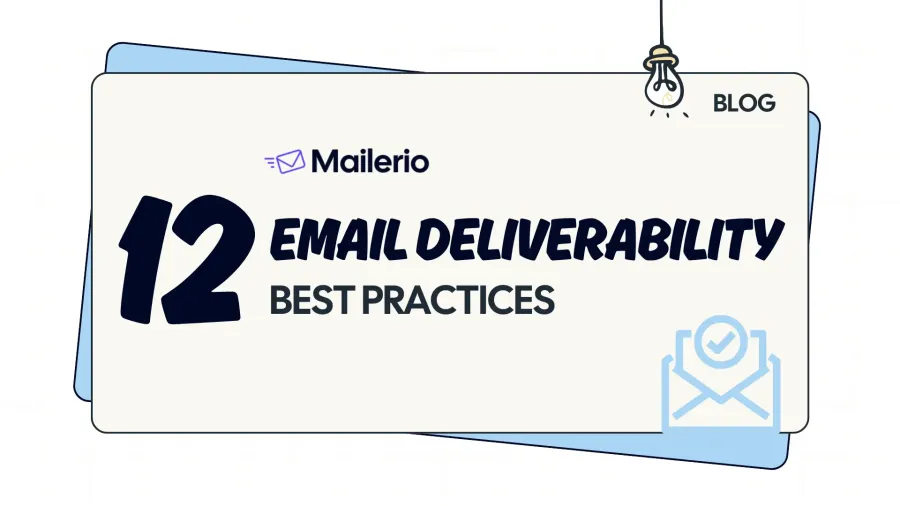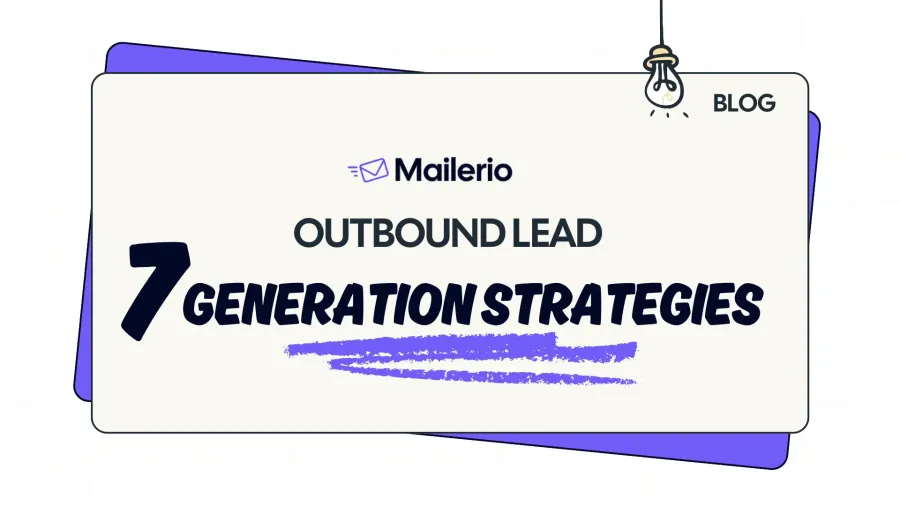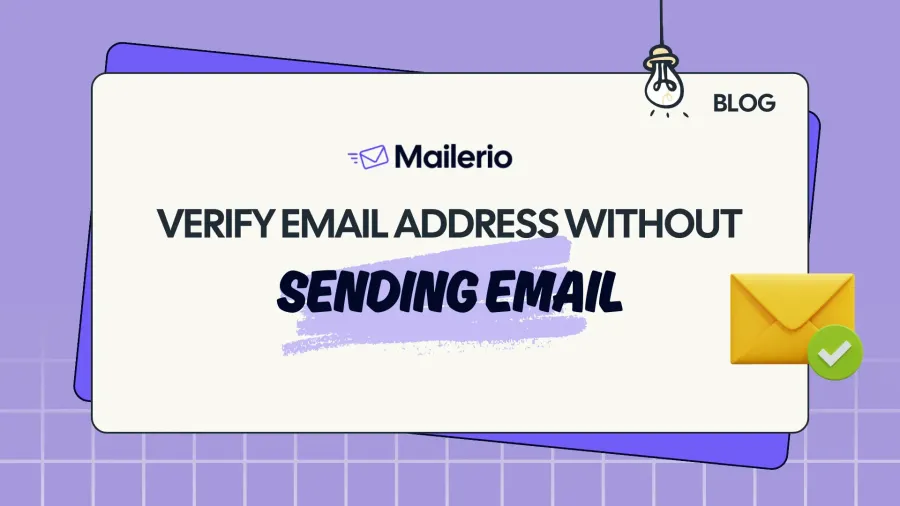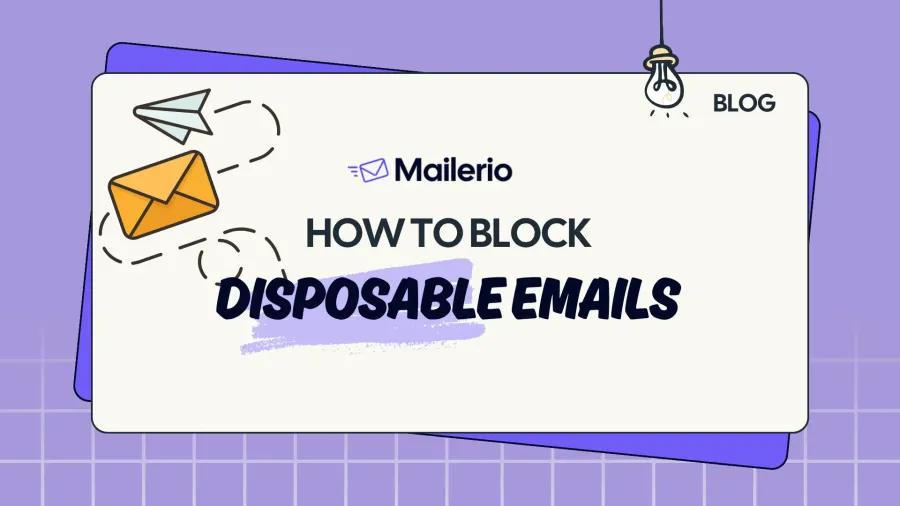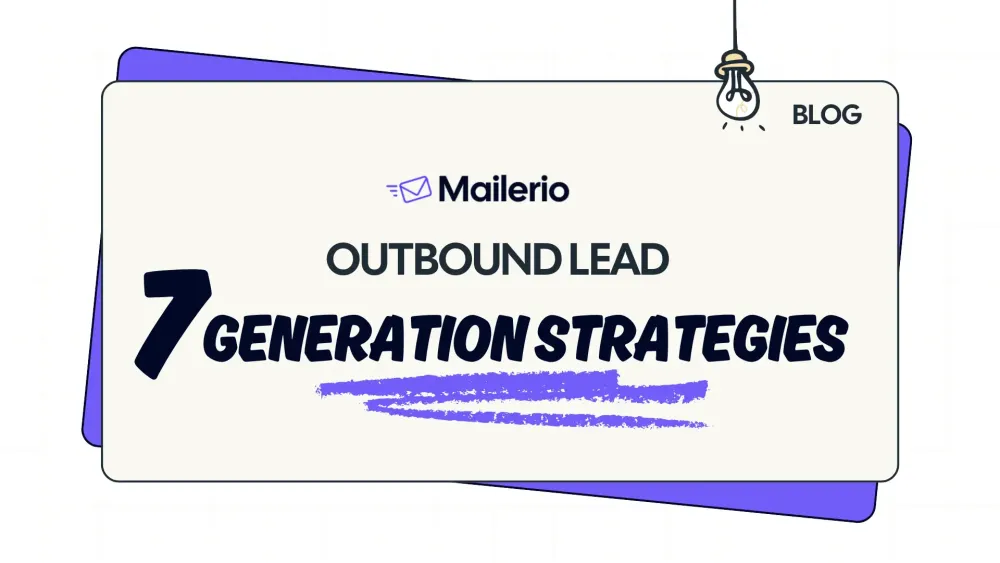
Maintaining a strong revenue stream is a constant challenge for founders and marketing teams. So outbound lead generation is a tempting strategy for founders, SaaS, and marketing teams. It revolves around actively reaching out to potential customers rather than waiting for them to find you. This proactive approach is key to driving revenue growth, even in 2025.
Table of contents:
- What is Outbound Lead Generation?
- 7 Top Outbound Lead Generation Strategies
- How Outbound Lead Generation Works
- Outbound Lead Qualification: Turning Leads Into Revenue
- Personalization & Next-Level Automation
- Outbound Tech Stack Comparison Table
- Why Deliverability & Data Hygiene Matter More Than Ever
- Common Outbound Mistakes & How to Avoid Them
- Trends & The Future of Outbound Lead Gen
- Conclusion
- FAQ: Outbound Lead Generation
Let’s explore outbound strategies that truly deliver results.
TL;DR
Outbound lead generation actively reaches out to potential customers through various channels like email, calls, and social media. Success lies in strategies such as cold emailing, cold calling, social selling, and account-based marketing. Having clean, accurate data is crucial. Tools like Mailerio play a vital role in protecting sender reputation, boosting deliverability, and increasing ROI.
Bad data can drain up to 30% of your revenue. Verified lists, on the other hand, can drastically reduce bounce rates to below 2% and deliverability up to 98-99%.
This guide includes workflows, metrics, and tech recommendations tailored for founders, SaaS leaders, and outreach experts.
What is Outbound Lead Generation?
Outbound lead generation is reaching out to potential customers rather than waiting for them to come to you. This approach contrasts with inbound strategies, where prospects are drawn in through content and various engagement tactics.
Outbound vs. Inbound
Inbound marketing focuses on attracting people by providing valuable and relevant content, while outbound marketing relies on pushing messages to a broad audience in order to capture attention.
Inbound works like a magnet, pulling customers in when they are ready and interested, whereas outbound functions more like a loudspeaker, broadcasting messages whether the audience is receptive or not.
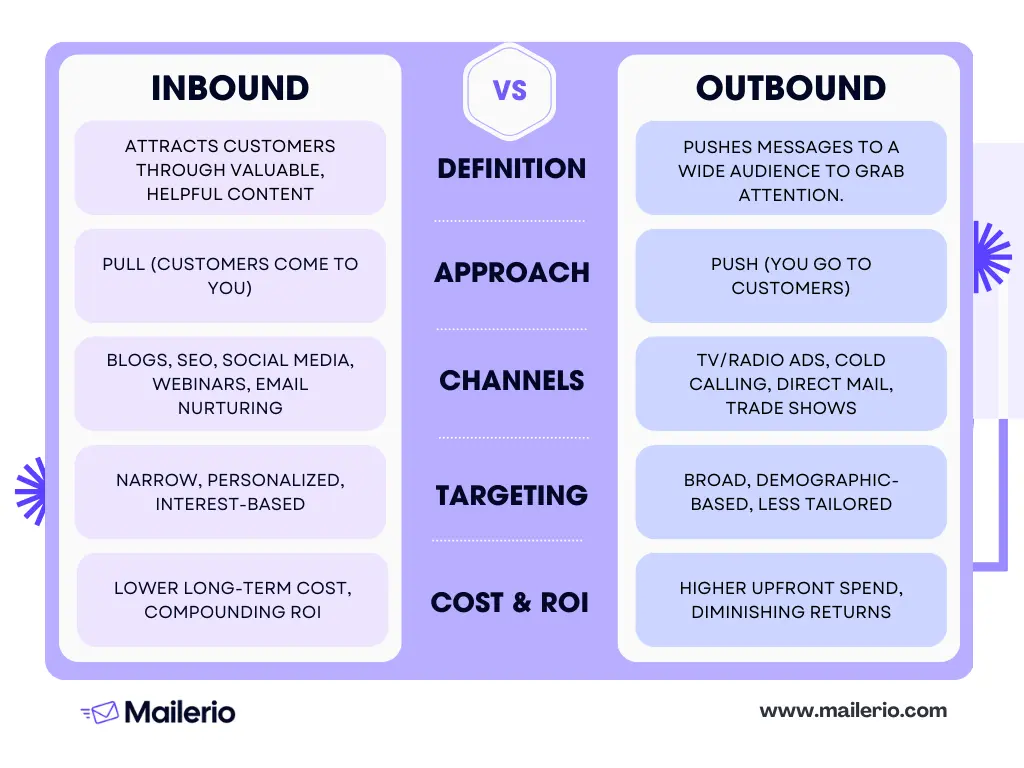
Both channel strategies also differ significantly. Inbound thrives through blogs, SEO, social media, webinars, and nurturing email campaigns, while outbound makes use of TV and radio ads, cold calls, direct mail, trade shows, and display advertising. When it comes to targeting, inbound is narrow, interest-based, and highly personalized, while outbound takes a broader, demographic-driven approach that is less tailored to individual needs.
Outbound Examples From Industries
For SaaS companies, outbound lead generation might involve cold email campaigns, targeting specific niches or decision-makers within a company. Agencies might focus on partnerships, while ecommerce businesses often use phone prospecting to engage with larger retail clients.
In the B2B, LinkedIn remains a powerhouse for engagement. Outreach data shows LinkedIn messages can achieve reply rates around 20%, significantly outperforming cold emails, which average 5–6%, and cold calls, which succeed only 2–3% of the time. This makes social channels an integral part of effective modern outbound strategies.
7 Top Outbound Lead Generation Strategies
Here’s a curated list of what industry experts advise on the best outbound lead generation strategies.
#1 Cold Emailing
The first one to land on the list is cold emailing. Which is no surprise. The success lies in personalization; there’s no point in sending 1000 messages that are not even interested in your services or can’t even understand what you want from them.
Craft engaging subject lines and tailor your cadences to speak directly to your prospects. We researched the internet to find out what experts and Reddit have to say about this. And we found some really great subject lines you could also use:
- XX, am I off here?
- XX, (problem / pain point you solve for) initiatives for (company name)?
- XX, improving (problem / pain point) at (company name)?
- XX, can I get your feedback here?
- XX, ABC referred me (if you get a referral)
Always keep your ICP in mind and personalize the email to increase the chances of your prospect opening the email. There’s no one magic formula, so test it out and find what works best for you. Here’s just one example of how it would look in the mail:
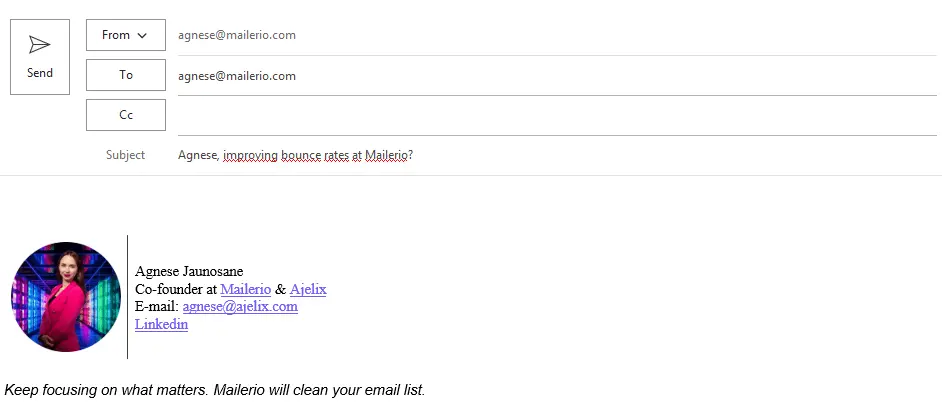
Always validate the emails before sending, so you wouldn’t end up in a spam box! Especially, if you’re using lead tools, the emails you find there aren’t always able to receive your email, and you can end up getting a hard bounce. Validating your email list with a tool like Mailerio is crucial. This ensures your emails land where they should, keeping bounce rates under the 2% mark that ISPs prefer for good sender reputation and excellent inbox delivery.
#2 Cold Calling
Timing is everything. Target the times decision-makers are most likely to answer. Early afternoons or mid-week can be optimal, as people tend to be less busy compared to Monday mornings or Friday afternoons.
Despite its potential, cold calling has evolved. With a success rate of around 2–3%, it’s less effective than some digital methods. However, it remains a valuable part of a diverse sales strategy, offering a personal touch that emails may lack.
Cold calling also requires persistence and adaptability. Prepare for rejections, but use them to refine your approach. Collect insights from these interactions to improve scripts and strategies, turning cold calls into more than just numbers on a list—they become learning opportunities.
#3 Social Selling
Platforms like LinkedIn and X offer huge opportunities. Craft compelling LinkedIn messages and strategic X outreach. LinkedIn InMails, for instance, boast nearly a 20% reply rate, outperforming standard cold emails or calls. LinkedIn is a powerful channel that works like a charm if used correctly.
Here’s a comment from Chris Cozzolino:
Our clients generate $15M+ in pipeline every quarter using these fundamentals. You’re not failing at LinkedIn. You’re failing at following the process.
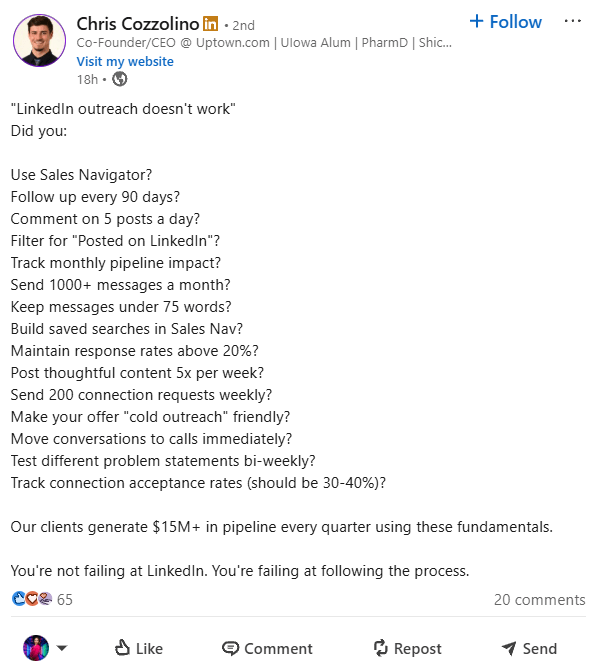

#4 Multi-Channel Outreach
A single touchpoint won’t cut it. Combining emails, phone calls, and social media interactions increases reach and response. Experts confirm that multi-channel strategies lead to better engagement than relying on one method alone.
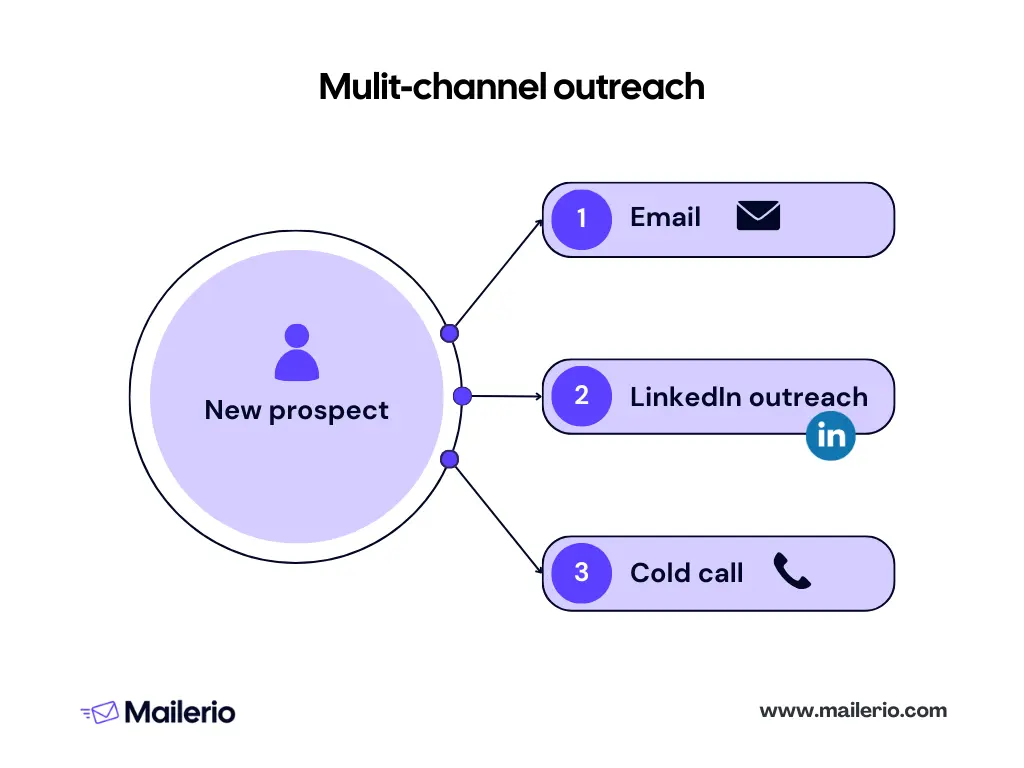

While email open rates are dropping, using a multi-channel approach guarantees better results and coverage over your ICP. A unified approach allows you to meet prospects where they are. Some might respond better to emails, while others are more comfortable on social media or via phone calls. By diversifying, you increase the odds of making a connection.
#5 Pay-Per-Click (PPC) for Outbound
Pay-Per-Click (PPC) is a smart way to re-engage prospects who’ve previously shown interest but didn’t convert. By using PPC, you can strategically place your brand back in front of these potential customers, reminding them of what they found compelling in the first place.
It helps reignite interest by targeting those who are already somewhat familiar with your product or service, potentially inching them closer to making a decision. This method efficiently pulls outbound leads back into your sales funnel, giving you another shot at conversion.
Here’s an example of a Google ad suggestion to upload customer match lists to target ads more precisely.
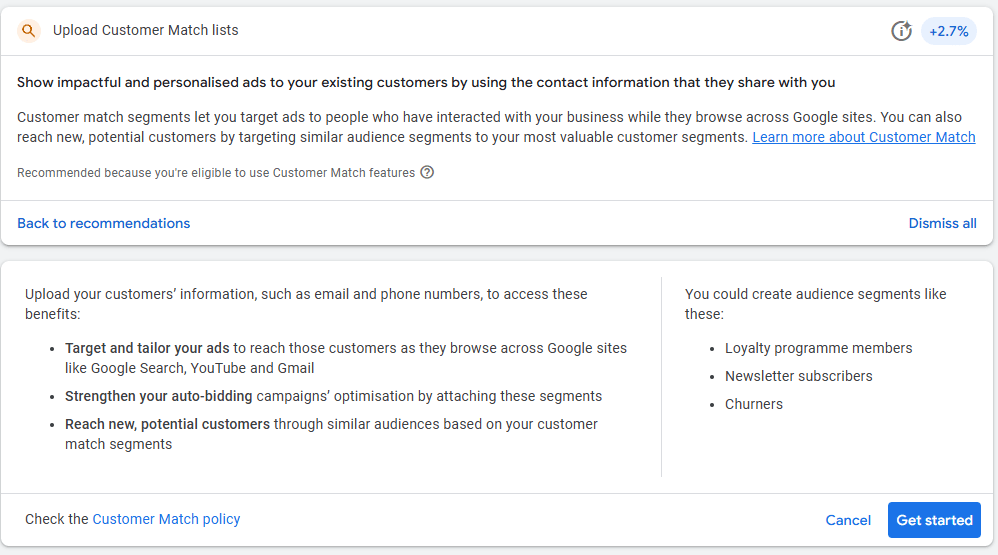

For this, you can use Meta, LinkedIn, or Google Ads to upload prospect lists and create lookalike audiences or target people who have already engaged with your business.
#6 Account-Based Marketing (ABM)
Account-based marketing is a focused approach where personalization is key. Instead of casting a wide net, zero in on high-value accounts. Each interaction is customized to align with their unique goals and requirements, making every touchpoint relevant and impactful.
By doing this, you build stronger relationships and increase the chances of converting these targeted accounts into loyal customers. This personalized experience resonates more with decision-makers, as it demonstrates a deep understanding of their business needs.
ABM also allows for more efficient resource allocation. Concentrating efforts on accounts that are most likely to yield significant returns ensures that the energy and resources spent are well worth the investment. Based on the ABMLA study, 76% of marketers report that ABM drives higher ROI than any other form of marketing, like omnichannel. This targeted approach often results in higher conversion rates, making it a favorite strategy among marketers aiming for quality over quantity.
#7 Event & Cold Approaching
Offline still works very well, especially in the AI-generated content era. Attend networking events, conferences, and engage in direct, face-to-face outreach. These personal connections can lead to fruitful relationships; it’s a great way to grow your audience or meet people who you would never be able to reach with email or socials. Plus, these connections are more valuable.
Here’s just one example of our COO, Agnese, speaking at a local event. These kinds of events are amazing for trust and can lead to opportunities and warm prospects.
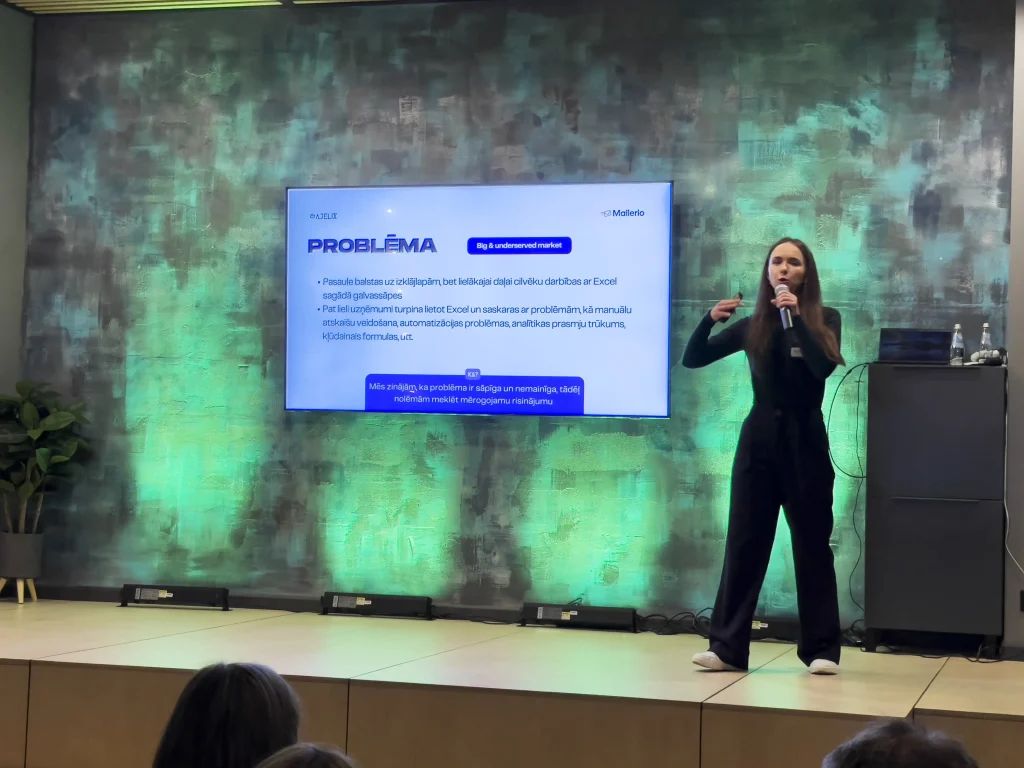

How Outbound Lead Generation Works
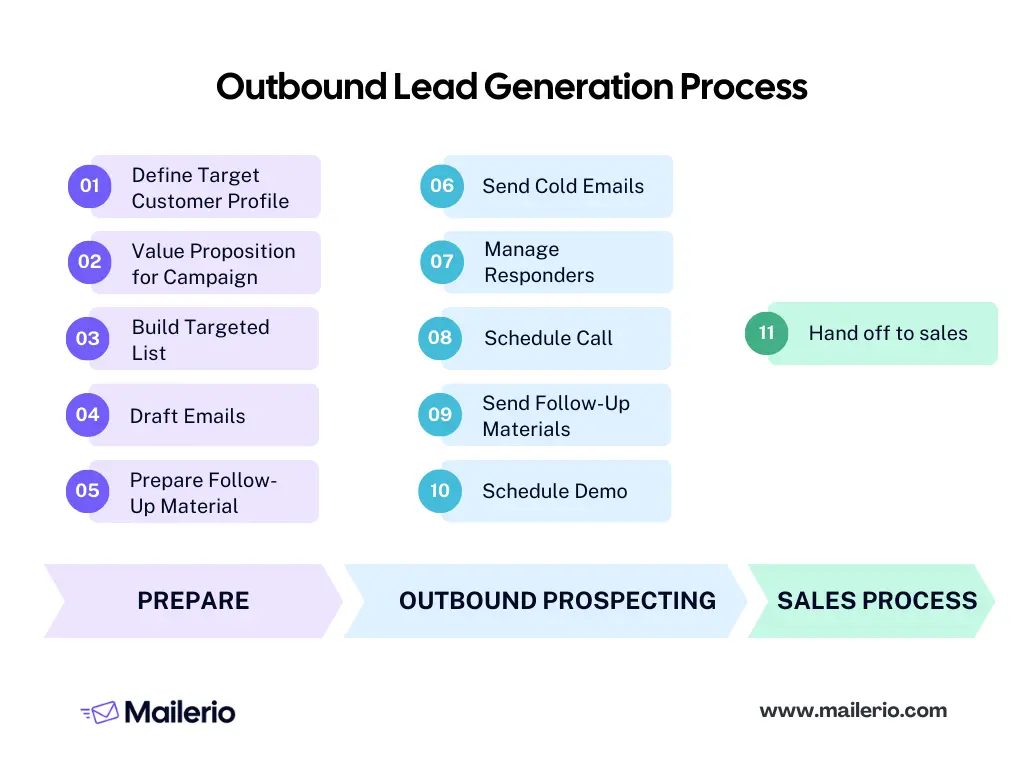

Time needed: 20 days
Implementing outbound lead generation involves a structured approach. There are six steps involved in this practice, but the process can vary from company to company and internal process. Let’s take a closer look at the email outbound lead generation process in more detail.
- Define Target Customer Profile
Start by clearly identifying who your ideal customer is. This includes demographics (industry, company size, location), firmographics (annual revenue, headcount), and psychographics (pain points, goals).
Tip: Use existing customer data, interviews, and market research to build a detailed profile. Tools like LinkedIn Sales Navigator, Apollo.io, or Clay can help narrow down your target audience. - Value Proposition for Campaign
Create a compelling value proposition that addresses the needs and pain points of your target customer. It should explain how your product or service solves their problem better than alternatives.
Tip: Focus on outcomes (time saved, revenue increased, risks reduced) rather than features. Craft 2–3 variations to test messaging effectiveness. - Build Targeted List
Gather a list of potential prospects who match your customer profile. This could involve using lead databases (mentioned above), LinkedIn, or manual research.
Tip: Prioritize quality over quantity. Use enrichment tools (like Apollo, ZoomInfo, or Clearbit) and verify email addresses with tools like Mailerio to reduce bounce rates. - Draft Emails
Write personalized outreach emails that are short, relevant, and engaging. The goal is to spark interest and start a conversation, not close the deal.
Tip: Keep the subject line concise, use personalization tokens (name, company, recent achievement), and always end with a clear call to action (CTA), like scheduling a quick call. - Prepare Follow-Up Material
Develop additional content (case studies, whitepapers, blog posts) that supports your message and nurtures prospects after the initial email.
Tip: Anticipate common objections and prepare materials that address them. For example, if prospects often ask about ROI, have a one-pager with proof points ready. - Send Cold Emails
Begin your outreach by sending cold emails to your targeted list. Make sure they are personalized and spaced out over time to avoid spam filters.
Tip: Use email automation tools (like Outreach, Salesloft, or Lemlist) to manage campaigns while maintaining personalization. Track open and reply rates to refine subject lines and messaging. Make sure to validate emails before sending to avoid bounce rates and protect your sender reputation. - Manage Responders
Monitor and respond promptly to replies, whether positive, negative, or neutral. Quick and thoughtful responses increase your chances of moving prospects forward.
Tip: Set up an organized system (CRM or sales engagement tool) to categorize leads into hot, warm, or cold for easier follow-up. - Schedule Call
When a prospect shows interest, the next step is to schedule a discovery call. The purpose is to understand their pain points and assess if they’re a good fit.
Tip: Use scheduling tools like Calendly to reduce back-and-forth. Prepare a list of open-ended questions to uncover challenges and goals. Here’s what a Calendly schedule looks like. It’s simple, and prospects can choose the best time without the need to spend time back and forth aligning times.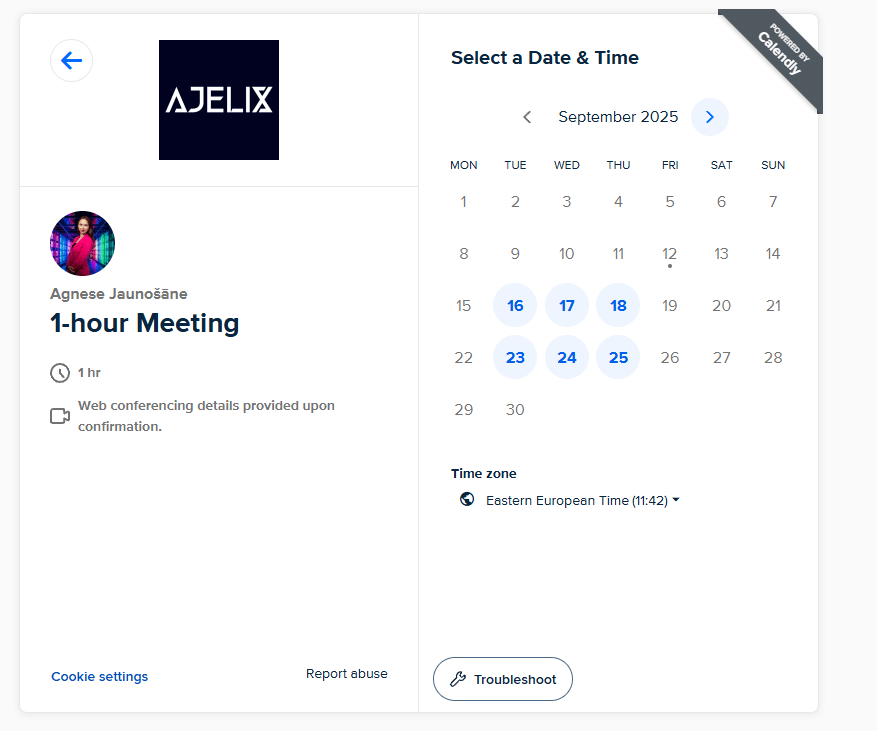
- Send Follow-Up Materials
After the call, send relevant materials that reinforce your value proposition, such as product sheets, case studies, or a recap of the discussion.
Tip: Tailor the content to what was discussed on the call. If the prospect mentioned a specific challenge, send a success story related to that exact issue. - Schedule Demo
If the lead is qualified, invite them for a demo to showcase your solution in action.
Tip: Keep the demo focused on solving the prospect’s problems, not showing every feature. Personalize it with real-life use cases and data relevant to their industry. - Hand-Off to Sales
Once the prospect has engaged and shown serious interest, pass them over to the sales team to close the deal.
Tip: Provide sales with a detailed hand-off, including call notes, objections raised, and resources already shared. This ensures a smooth transition and avoids repeating conversations.
Protect Your Sender Reputation With Mailerio!
Sign Up & Get 100 Credits Upon Registration
Outbound Lead Generation Qualification: Turning Leads Into Revenue
Turning outbound leads into revenue hinges on effective lead qualification. The magic trio: Intent, Fit, and Engagement plays a pivotal role.
- Intent: grasp what the prospect truly needs and their intent. This understanding sets the stage for meaningful interaction.
- Fit: ensure there’s a solid alignment between the prospect and your offering.
- Engagement: engage them thoughtfully, making each interaction valuable.
By focusing on these aspects, you can prioritize leads that are most likely to convert, optimize your sales efforts, and improve ROI.
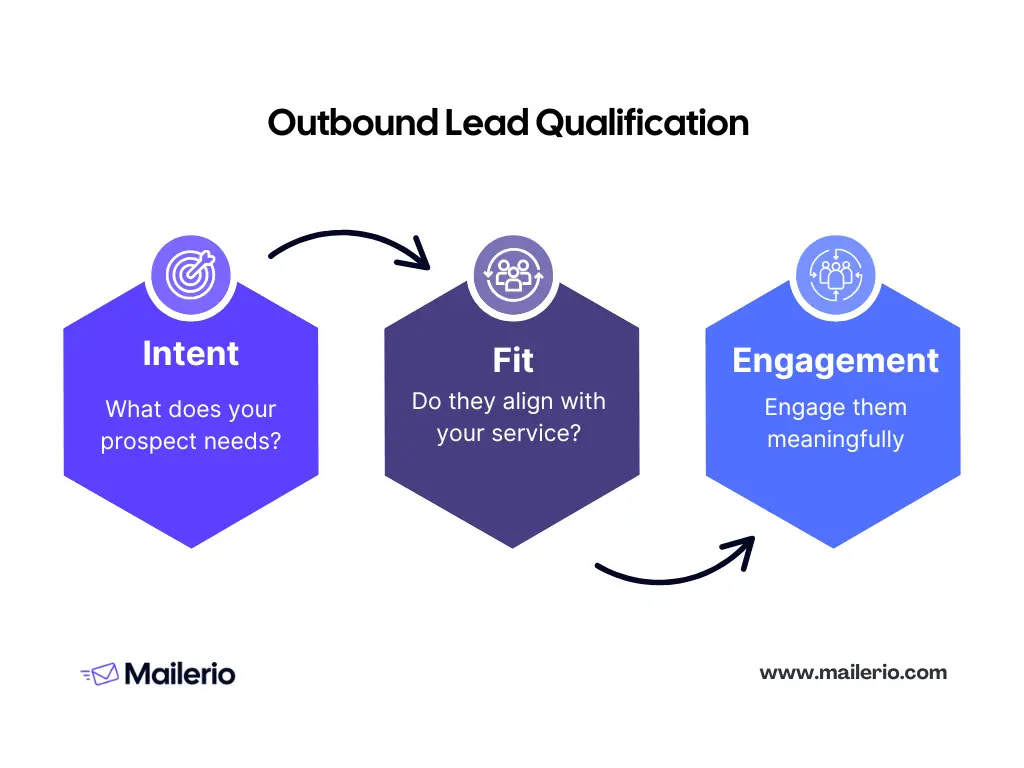

If you’re doing an email outreach, make sure your email lists stay clean by validating emails before sending. This will help you protect the email sender’s reputation and avoid bounce backs.
Protect Your Sender Reputation With Mailerio!
Sign Up & Get 100 Credits Upon Registration
Personalization & Next-Level Automation
Personalization is key to effective outbound lead generation. By using AI and dynamic content, you can tailor each message to resonate with your prospects. But it goes further than simply inserting a name into an email, it’s about using data to craft content that speaks directly to the recipient’s needs and interests.
To take it a step further, setting up intent triggers and automated sequences saves time and enhances efficiency. Imagine your outreach adjusting in real-time based on a prospect’s interactions, pretty powerful, right?
Author’s note: Now, before you automate anything, make sure the manual process is set up properly. Before sending batches of emails, implement list cleaning by using real-time validation tools like Mailerio to ensure your messages land where they should, in the inbox. This strategy not only maintains your sender reputation but also maximizes your outreach success.
Maja Voje, the author of GTM Strategist, wrote about outbound in the AI era in her latest newsletter. How we’re shifting marketing approaches, rather than just spraying thousands of emails, we should create a process with a vision. Here’s the go-to market intelligence platform she wrote about 👇
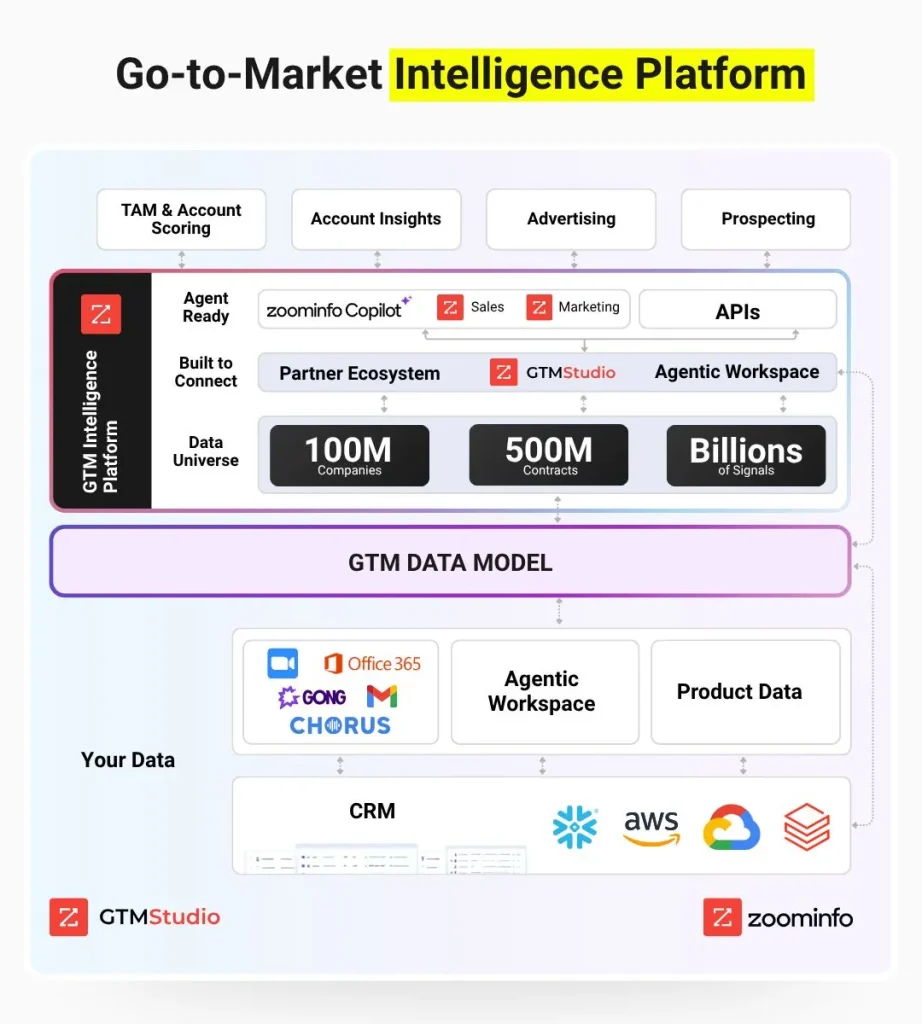

She explains that signals are different events that can happen to a business, like product launches, leadership hires, etc. These events are signals that you have to act instead of waiting for someone to come to you from inbound channels.
Personalizing and automating your outbound approach is a must, but make sure you have a solid system in place, backed by robust validation to keep you ahead of the curve.
Outbound Lead Generation Tech Stack Comparison Table
In outbound lead generation, having the right tools is crucial. Selecting tools goes beyond just functionality. It’s about choosing solutions that integrate seamlessly and enhance the effectiveness of your campaigns. For CRM, look for platforms that offer robust integrations and automation capabilities. When it comes to outreach, multi-channel tracking is key to understanding and optimizing your engagement strategies.
| Category | Tools | Key Features |
|---|---|---|
| CRM | Salesforce, HubSpot, Pipedrive, Zoho | Lead & account management, pipeline tracking, reporting, integrations with marketing/sales tools |
| Sales Engagement Platforms | Outreach, SalesLoft, Apollo.io, Groove | Multi-channel sequencing (email, calls, LinkedIn), task automation, analytics, rep productivity tools |
| Data Providers & Enrichment | ZoomInfo, Lusha, Clearbit, Apollo.io | B2B contact databases, company enrichment, intent signals, integration with CRM/engagement tools |
| Dialers & Calling Platforms | Aircall, RingCentral, CloudTalk, Dialpad | VoIP calling, power dialers, call recording, CRM integrations, call analytics |
| Email & Deliverability Tools | Mailerio, SendGrid, Postmark, Lemlist | High-volume sending, deliverability optimization, warm-up, email tracking |
| SMS & Messaging Platforms | Twilio, Podium, Sakari, WhatsApp Business API | SMS campaigns, 2-way texting, WhatsApp & voice APIs, integration with CRM/marketing tools |
| Marketing Automation | HubSpot Marketing Hub, Marketo, Pardot (Salesforce), ActiveCampaign | Automated campaigns, email marketing, lead nurturing, landing pages, analytics |
| Conversation Intelligence & Analytics | Gong, Chorus, ExecVision, Avoma | Call recording, AI insights, conversation analytics, deal coaching |
| Video Prospecting & Demos | Vidyard, Loom, Hippo Video, BombBomb | Personalized video outreach, screen recording, tracking engagement with prospects |
| Advertising & Outbound Marketing | LinkedIn Ads, Google Ads, Metadata.io, RollWorks | Targeted ads, account-based marketing (ABM), retargeting, lead gen |
| Collaboration & Communication | Slack, Microsoft Teams, Zoom, Google Meet | Team messaging, video meetings, file sharing, workflow integrations |
Data accuracy and compliance are non-negotiable in the data segment. Tools like Apollo and Cognism provide rich datasets, while Mailerio ensures the data’s validity. For email validation, Mailerio stands out with no subscription fees, offering affordability without compromising on performance. Choose these tools to build an efficient, results-driven outbound strategy that maximizes every outreach effort.
Protect Your Sender Reputation With Mailerio!
Sign Up & Get 100 Credits Upon Registration
Why Deliverability & Data Hygiene Matter More Than Ever
Handling dirty lists can seriously undercut your email deliverability, leading to wasted effort and missed opportunities. Sending to invalid addresses not only harms your sender reputation but also slashes your ROI. Gartner’s research highlights a critical point: organizations can lose up to 30% of revenue due to poor data hygiene and dirty email lists that include disposable or temporary emails.
This is where Mailerio comes into play. By offering bulk list cleaning before campaigns and real-time validation via API for forms and CRMs, Mailerio acts as a crucial foundation for your email success.
Common Outbound Mistakes & How to Avoid Them
Outbound lead generation can be tricky. Here are some common pitfalls and how to navigate them:
- Over-automation and Impersonal Messaging: Automating everything might seem efficient, but it can make your messages feel robotic. Strike a balance between automation and a human touch to keep your outreach personable and engaging.
- Outdated or Dirty Email Lists: Using old or inaccurate lists wastes time and resources. Automate validation with tools like Mailerio. Clean lists significantly cut the risk of blacklistings and prevent wasted sends. After proper cleaning, bounce rates typically drop under 2%, improving overall deliverability.
- Ignoring Reply Management: Not managing responses effectively can mean missed opportunities. Ensure that someone is actively engaging with replies to nurture relationships and move leads through the funnel.
- Not Tracking Sender/Domain Health: Keeping an eye on your sender and domain health is crucial. Regular monitoring helps maintain a strong reputation, ensuring your messages land where they should.
- Relying on a Single Channel: Putting all your eggs in one basket limits reach. Embrace a multi-channel approach by combining emails, calls, and social media. This increases your chances of connecting with prospects effectively.
Avoiding these mistakes will strengthen your outbound strategy, leading to better engagement and higher ROI.
Trends & The Future of Outbound Lead Gen
Outbound lead generation is evolving rapidly, with several key trends reshaping the landscape. Intent-based outreach is gaining traction, allowing businesses to target prospects based on behavior and signals. Predictive lead scoring is also becoming essential, using data to prioritize leads that are most likely to convert.
Automation is accelerating, particularly in messaging, with AI-written content helping teams scale personalized outreach. However, the backbone of all these advancements is clean, real-time data validation. Tools like Mailerio ensure your contact lists remain accurate, reducing bounce rates and protecting sender reputation.
Experts anticipate that as ISPs and compliance standards evolve, leveraging automation alongside impeccable data hygiene will be crucial. This combination will future-proof outbound efforts, ensuring your campaigns remain effective and compliant. Check out more insights on data hygiene from Suped.
KPIs & Metrics That Matter
Tracking the right metrics is key to optimizing your outbound efforts. Let’s dive into the numbers that truly make an impact.
- Open, Reply, and Conversion Rates: These are the lifeblood of any campaign. High engagement metrics indicate that your messaging resonates with your audience and guides you on what works.
- Validation Metrics: Pay attention to bounce rate benchmarks and inbox placement.
- Improving Performance: Use these metrics to refine your outreach strategy. Visual tools like tables and infographics can help you track progress over time, making it easier to notice trends and adjust tactics.
Understanding and acting on these KPIs ensures your outbound lead generation strategies are not only effective but also continually improving.
Wrap Up
Outbound lead generation thrives on intent, persistence, and quality data. Getting these elements right can redefine your success metrics. A strong sender reputation, backed by validated lists, forms the backbone of sustainable ROI. It’s not just about sending emails—it’s about making sure they land where they should.
Why not see the difference yourself? Try Mailerio for free. Validate a sample list or get a personalized deliverability report to start boosting your results.
FAQ: Outbound Lead Generation
What are outbound leads vs. inbound leads?
Outbound leads are prospects reached through proactive methods like cold emails, calls, and social media. In contrast, inbound leads come to you via channels like content marketing and SEO.
How do I qualify an outbound lead?
Qualifying involves assessing factors like intent, fit, and engagement. This ensures your efforts focus on prospects most likely to convert.
How do I integrate email validation with my CRM?
Most modern CRMs support integration with email validation tools like Mailerio. This ensures real-time updates and maintains clean, reliable data across the board.
Does better data directly increase outbound ROI?
Yes. According to Gartner research, B2B businesses can lose up to 30% of revenue due to bad data. Proper validation boosts deliverability to 98–99%, improving ROI.
Are there compliance or GDPR concerns in outbound?
Yes, ensuring that your data practices comply with regulations like GDPR is crucial. Always obtain proper consent and manage data responsibly.
Why pick Mailerio over other email validation options?
Mailerio offers affordability, high accuracy, and seamless integration without requiring a subscription, making it a smart choice for maintaining top-notch data hygiene.
